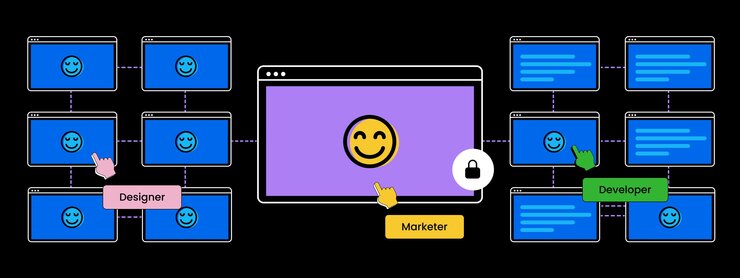Whether you want to tweak a few things or extensively customize Builder, it provides the necessary features and capabilities to tailor the experience to your team's specific needs.
This document provides an overview of the various features and capabilities available to customize Builder, including the Visual Editor, data integration, team collaboration, and content governance. With these customization options, you can:
- Tailor the Visual Editor to match your team's workflows and content requirements
- Integrate Builder with your existing data sources and external systems
- Establish a collaborative and governed content creation process (Enterprise plans)
In the following sections, you'll find detailed information and links to relevant documentation for each customization option.

The Visual Editor is the primary interface for content creation in Builder. It provides a range of customization options to adapt the editing experience to your team's specific requirements.
These customization options include extending functionality through plugins, incorporating design tokens to maintain brand consistency, adding custom fields to capture specific data points, and utilizing custom components to create reusable building blocks.
By leveraging these features, you can create a tailored editing environment that aligns with your team's workflow and content structure.
- Custom Components: Register and use custom components in the Visual Editor, including setting component options and defining their inputs.
- Components-only Mode: Limit visual editing to only custom components, providing more structured and controlled content creation.
- Custom Fields: Understand how to add and configure custom fields on your models, which can then be used in the Visual Editor for a customized editing experience.
- Design Tokens: Incorporate your design tokens into the Visual Editor to maintain brand consistency while streamlining content creation.
- Extending Builder with Plugins: Customize Builder's Visual Editor by adding new tabs, toolbar buttons, and other features using plugins

Integrate with your non-Builder data sources and systems. Use Data models to manage structure and organize content, along with custom fields to capture specific data points.
Webhooks enable real-time synchronization of content changes, automation of tasks, and triggering of workflows based on events such as content publishing or updates.
These features facilitate seamless data flow and integration between Builder and other tools in your tech stack.
- Data Models: Create, manage, and integrate data models in Builder to implement structured data like navigation links, product data, and site theme colors by non-coding teammates.
- Custom Data and Context: Implement custom actions for specific behaviors or workflows needed by your team. These can be triggered within the Visual Editor or on content creation.
- Webhooks: Sync content changes, automate tasks, and integrate with external systems based on events like publishing or updating content.
- Model Webhooks: Sync content changes by model, triggering workflows like database updates or cache busting.

As teams grow and content requirements evolve, scalability requires establishing effective collaboration and governance practices.
Builder supports effective team collaboration and content governance through custom roles and permissions for granular access control, as well as environments for managing content across different stages of the development lifecycle.
- Environments (Enterprise): Create the environments you need for your team's workflow, such as Dev, QA, or Production.
- Custom roles and Permissions (Enterprise add-on): Set up custom roles and permissions to ensure that team members have access only to the parts of Builder that they need. This minimizes the risk of accidental changes to critical parts of the site.
- Rules and Workflows for Content Governance (Enterprise add-on): Implement structured content creation processes, define publishing permissions, and enforce quality control measures.
These features are exclusive to the Enterprise plan. For more features available on Enterprise, visit the Enterprise Hub.



